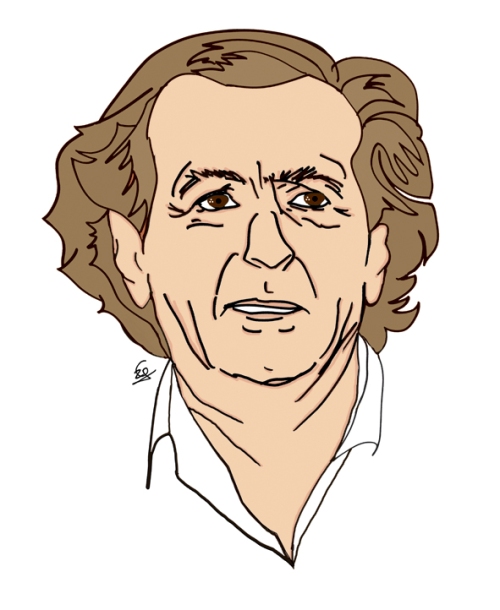By Harry van Versendaal
“I like the idea of living your work, writing your life. My life is like a text I can endlessly correct,” Bernard-Henri Levy said in an interview with Vanity Fair’s Joan Juliet Buck some years ago.
He could definitely do with some whiteout right now.
France’s star philosopher, with his trademark unbuttoned white shirts, has really embarrassed himself this time. In his latest book, “De la guerre en philosophie” (Of War in Philosophy), Levy takes potshots at 18th-century German heavyweight Immanuel Kant calling him, among others, “raving mad” and a “fake.”
To add to his firepower, Levy, known in France by his initials BHL, employs the devastating critique of Jean-Baptiste Botul — more specifically of his lectures to the neo-Kantians of Paraguay, where Botul once and for all debunks their hero as “an abstract fake, a pure spirit of pure appearance.”
Save for one little problem: Botul is no more real than a Greek budget surplus. Botul, the intellectual founder of Botulism and writer of, well, “The Sex Life of Immanuel Kant,” is a fabrication of Frederic Pages, a French journalist. Far from unbuttoned, the emperor appeared to be wearing no clothes at all.
It’s hard to see how BHL fell for this one, given that even Wikipedia describes Botul as a fictional French philosopher. Still, Levy tried to put on a brave face. “As it turns out, it was a hoax. It was a truly brilliant and very believable hoax,” the author said last week. “Hats off for this invented-but-more-real-than-real Kant, whose portrait, whether signed Botul, Pages or John Smith, seems to be in harmony with my idea of a Kant who was tormented by demons that were less theoretical than it seemed.”
But few people would buy that one.
Leaving his bedroom habits aside, biographers agree that Kant lived a rather mundane life. He was born, lived and died in Konigsberg, a Prussian university town that is now Kaliningrad, Russia. He was so regular in his habits, legend has it, that locals used to set their clocks by his afternoon walk.
BHL, on the other hand, is not exactly what you call low-profile. With his wind-swept hairstyle, golden tan and designer suits, Levy is the modern-day reincarnation of left-bank philosophers, that peculiarly French breed of celebrity thinker. Before turning into a regular fixture on France’s TV panels and Paris Match weekly, Levy was the founder and main voice of France’s “nouveaux philosophes,” an anti-communist and unusually pro-American movement in the 1970s.
His media savviness, perceived hollowness and narcissist know-it-all style have won him many enemies, including late philosophers Cornelius Castoriadis and Gilles Deleuze. BHL is probably what inspired sociologist Pierre Bourdieu’s bashing of “les fast thinkers,” the instant experts endlessly parading on the nation’s television sets.
In their book “Une Imposture Francaise” (A French Imposter), journalists Nicolas Beau and Olivier Toscer paint an elaborate profile of BHL; and it’s not a very flattering one: “A philosopher who’s never taught the subject in any university, a journalist who creates a cocktail mingling the true, the possible and the totally false, a patchwork filmmaker, a writer without a real literary oeuvre, he is the icon of a media-driven society in which simple appearance weighs more than the substance of things. BHL is thus first and foremost a great communicator, the PR man of the only product he really knows how to sell: himself.”
Not surprisingly, his enemies prefer to call him BHV after France’s department store: It has something for everyone.
Worse, perhaps, Levy has been accused of cozying up to socialists (Francois Mitterrand) and conservatives (Nicolas Sarkozy) alike, depending on the political zeitgeist, partly in order to push the career of his feline actress wife Arielle Dombasle, whether as head of the commission for the promotion of French cinema or, later, as president of the state-owned Arte network.
So many were delighted with BHL falling for the prank, even though it was not directed against him. In that sense, it was different when author William Boyd pulled a scam in the late-90s with the aim of exposing the pretensions of the art world’s glitterati. For years, Boyd had been crafting the portrait of Nat Tate, a supposedly talented albeit forgotten American painter. A friend of Pablo Picasso and a lover of Peggy Guggenheim, an abstract expressionist suffering from depression, Tate killed himself at the age of 31 after destroying all, or in fact (pun intended) “99 percent,” his work.
On the eve of April Fools’ Day of 1998, Boyd launched his biography of Tate by throwing a party that attracted the typical New York art crowd. He was not alone in the trick. David Bowie read extracts from the book which included endorsements by Picasso biographer John Richardson and author Gore Vidal — “an essential dignified drunk with nothing to say,” the latter recalled on the dust jacket. The funny thing is more people that night recalled their own meetings with Tate.
Ironically, Kant held that we cannot grasp the world as it really is; we can only know the things as they appear to us — yet it’s doubtful that BHL or other prank victims will turn to the German for comfort.
Poor Levy, would have been better off trusting the words of Monty Python instead: “Immanuel Kant was a real pissant, who was very rarely stable.”
